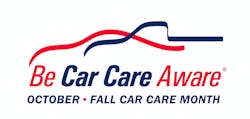October is Fall Car Care Month, and we looked to the Car Care Council and the National Institute for Automotive Service Excellence (ASE) for recommendations and safety tips to share with your customers on basic fall maintenance procedures. Whether you perform the safety checklist or they do (direct mail, anyone?), here are their top 16.
- Read the owner’s manual in order to follow the vehicle manufacturer’s recommended service schedules.
- Check the vehicle’s fluids, including power steering, brake and transmission fluid and engine oil, as well as antifreeze/coolant. Dirty oil can spell trouble in the winter, says the Car Care Council. The customer may want to consider changing over to a “winter weight” oil. The cooling system should be flushed and refilled as recommended. The level, condition, and concentration of the coolant should be checked periodically. A 50/50 mix of antifreeze and water is usually recommended.
- Examine hoses and belts to make sure they are not cracked, brittle, frayed, loose or showing signs of excessive wear.
- Check the condition of the filters, such as air, fuel and PCV. Point out to customers that a poorly running engine is less efficient and burns more gasoline, thus costing them more money.
- Advise them to add a bottle of fuel deicer to the vehicle’s fuel tank once a month, especially before the temperature drops below freezing, to help keep moisture from freezing in the fuel line. According to ASE, keeping the tank filled also helps prevent moisture from forming.
- Take care of existing engine performance and driveability problems. Cold weather makes hard starts, rough idling, stalling, diminished power, etc., worse, notes ASE.
- Check the battery. The connection must be clean, tight and corrosion-free.
- Inspect the brake system, including the brake linings, rotors and drums.
- Check the exhaust system for leaks, damage and broken supports or hangers if there is an unusual noise. The vehicle’s trunk and floorboards should also be inspected for small holes.
- Examine the heating, ventilating and air conditioning (HVAC) system. Proper heating and cooling performance is critical for interior comfort and for safety reasons such as defrosting.
- Examine the steering and suspension system. The involves looking at the shock absorbers, struts and chassis parts such as ball joints, tie rod ends and other related components.
- Check the tires. That includes checking the pressure and tread depth. Customers need to understand worn tires are dangerous in winter weather. Should they switch to winter tires? Check the spare, and be sure the jack is in good working condition.
- Replace worn windshield wipers so they can see clearly when driving during precipitation. Rubber-clad (winter) blades are a good idea to fight ice build-up in a harsh climate. Remind your customers to stock up on windshield washer solvent (there are fluids specifically formulated for winter weather) and to always carry an ice scraper and snow brush.
- Check that all interior and exterior lighting is working properly and replace burned out bulbs. Make sure the vehicle’s headlights are properly aimed. Road grime needs to be removed from all lenses. To prevent scratching, never use a dry rag. Clouded lenses can be refinished.
- Tell customers to keep the gas tank at least halfway full during the cold months to prevent moisture from forming in gas lines and possibly freezing, says the Car Care Council.
- Remind your customers to always carry an emergency kit with extra clothes and gloves, boots and blankets; flares; a small shovel and sand or kitty litter; tire chains; bottled water; a first aid kit with any critical medications; a flashlight and extra batteries; and a cell phone and extra car charger. Plus, put a few “high-energy” snacks in the glove box, ASE recommends.
The Car Care Council also offers a free, personalized maintenance schedule and email reminder service on its website www.carcare.org. It is an easy-to-use resource designed to help your customers “drive smart, save money and make informed decisions.” The council’s Car Care Guide is also available.
Regular, routine maintenance can help your customers improve their gasoline mileage, reduce pollution, and catch minor problems before they become big headaches, says Tony Molla, vice president of communications at ASE. For more information, see www.ase.com.
About the Author

Bob Ulrich
Bob Ulrich was named Modern Tire Dealer editor in August 2000 and retired in January 2020. He joined the magazine in 1985 as assistant editor, and had been responsible for gathering statistical information for MTD's "Facts Issue" since 1993. He won numerous awards for editorial and feature writing, including five gold medals from the International Automotive Media Association. Bob earned a B.A. in English literature from Ohio Northern University and has a law degree from the University of Akron.
